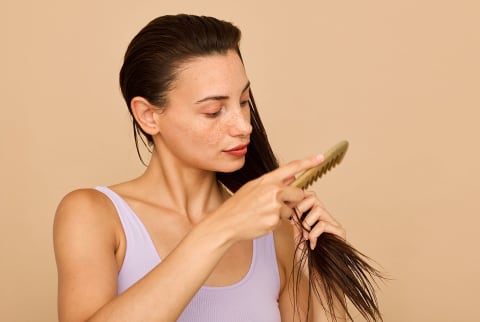Advertisement
Use This Type Of Treatment To Revive Dry, Damaged Hair


Once your strands have been damaged from bleach, heat, or other stressors, frizz, breakage, and dullness are sure to follow. While you can’t technically “heal” your hair (because strands are dead already), you can encourage healthier-looking hair via topical products.
Pick the right product, and your hair will appear shinier, feel smoother, and have a better defense against future damage. Which product should you select, you ask? Here's one to keep an eye out for and why it works like a charm.
What are bond-building products?
The buzzword: bond-builders. This is a general term for products that contain nourishing ingredients like keratin, biotin, hydrolyzed quinoa, amino acids, or proteins.
“Topical protein treatments such as keratin or bond-strengthening shampoos revitalize hair and promote stronger hair strands," hairstylist Miko Branch, co-founder of hair care brand Miss Jessie's, previously told mbg.
She adds, "Adding protein to hair is a terrific way to restore and nourish hair follicles, fostering hair health by protecting tresses and helping to prevent breakage.”
Not to mention, these bond-building proteins can even help with hair growth. "A good protein treatment can aid in the repair of severely damaged hair, hair growth, and the penetration and healing of a dry, flaky scalp," celebrity hairstylist Annagjid "Kee" Taylor adds.
See, a major key to encouraging hair growth is protecting the length you already have; breakage-prone strands can make your hair growth goals nearly impossible. By strengthening and rebuilding those broken amino acid chains, protein treatments can protect the hair from damage and keep it healthy—and as a general rule, healthy hair grows way faster.
Does your hair need protein?
If your hair doesn't have enough protein, it can appear dry, brittle, and straw-like. A lack of protein also affects the strands' elasticity, so NYC-based hairstylist Matt Newman recommends what he calls the "stretch test."
- Take a strand of hair from your brush and tug it gently: "It should have a little bit of stretch, and it should resist your tug," he says.
- If the hair instantly snaps in half somewhere in the middle, that's a sign your strands may need more protein. "At a perfect, balanced state, hair should have a mild elasticity, and it should be able to be detangled properly without breaking," he adds.
If you’re ready to add these powerful products to your routine, start here with a curated list of the best protein treatments for hair and hair masks for damaged hair.
The takeaway
While you can’t completely reverse the damage done to your strands, you can encourage healthier look, feel, and function of your strands with bond-building products. However, you should only use these productions on occasion, specifically as instructed. It is possible to have protein overload—to learn more about how it affects your hair (and how to spot it), check out this story.